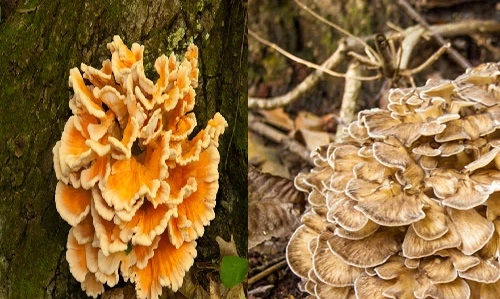Foraging for wild mushrooms has become increasingly popular among homeowners, food enthusiasts, and outdoor adventurers across the USA. Among the many fascinating fungi, two stand out not only for their unique names but also for their culinary and ecological importance: Chicken of the Woods and Hen of the Woods. Despite their similar names, these mushrooms are very different in appearance, taste, habitat, and uses.
In this article, we’ll explore the key differences between Chicken of the Woods (Laetiporus) and Hen of the Woods (Grifola frondosa), helping you identify, harvest, and enjoy these delicious fungi safely and effectively.
What is Chicken of the Woods?
Chicken of the Woods is the common name for a group of mushrooms in the genus Laetiporus. Known for its bright colors and meaty texture, this mushroom is a favorite among foragers and chefs who value its ability to mimic the taste and texture of chicken.
Identification:
- Appearance: Chicken of the Woods has bright yellow, orange, or golden shelves that grow in overlapping clusters on trees. The color often fades to white as the mushroom ages.
- Texture: The flesh is soft, tender, and slightly spongy when young, becoming tougher with age.
- Underside: The underside has tiny pores rather than gills. This is an important identifier.
- Habitat: It typically grows on dead or dying hardwood trees like oak, cherry, or eucalyptus. Occasionally, it appears on conifers, though these specimens may cause gastrointestinal discomfort.
- Season: Chicken of the Woods appears in the summer and fall in many regions of the United States.
Culinary Uses:
Chicken of the Woods is famous for its meat-like texture and its ability to substitute chicken in recipes. When cooked, it has a tender, juicy consistency with a mild, lemony flavor.
Popular Dishes:
- Sautéed with garlic and butter
- Stir-fries or soups
- Breaded and fried as “chicken nuggets”
- Grilled or roasted
Cooking Tips: Always cook Chicken of the Woods thoroughly, as eating it raw can cause gastrointestinal issues. Avoid specimens growing on conifers, as they may cause adverse reactions.
Precautions:
While Chicken of the Woods is edible and enjoyed by many, some individuals may experience allergic reactions or stomach upset. Always try a small amount the first time you consume it.
What is Hen of the Woods?
Hen of the Woods, also known as Maitake (Grifola frondosa), is a mushroom that grows in large, ruffled clusters resembling the feathers of a hen. This mushroom is prized in the culinary world and traditional medicine for its earthy flavor and nutritional benefits.
Identification:
- Appearance: Hen of the Woods grows in large, dense clusters of grayish-brown, fan-shaped caps that overlap. The caps are soft and smooth with wavy edges.
- Texture: The flesh is tender and slightly fibrous, with a robust, chewy texture when cooked.
- Underside: The underside has small pores rather than gills.
- Habitat: Hen of the Woods grows at the base of hardwood trees, particularly oak trees. It often appears in the same location year after year.
- Season: It typically fruits in the fall, making it a sought-after autumn delicacy for foragers.
Culinary Uses:
Hen of the Woods is celebrated for its rich, umami flavor, often described as earthy, nutty, and slightly peppery. It is incredibly versatile and can enhance many dishes.
Popular Dishes:
- Sautéed as a side dish or topping for steak
- Added to soups, risottos, and stews
- Roasted or grilled for a deep, smoky flavor
- Used in stir-fries and pasta dishes
Cooking Tips: Hen of the Woods works well with simple seasonings like garlic, olive oil, and herbs, allowing its natural flavor to shine. It holds up well in soups and long cooking processes due to its hearty texture.
Nutritional and Medicinal Benefits:
Hen of the Woods is packed with nutrients and antioxidants. It contains beta-glucans, compounds that are believed to boost the immune system, reduce inflammation, and support overall health. This mushroom is commonly used in traditional medicine to promote wellness.
Key Differences Between Chicken of the Woods and Hen of the Woods
| Feature | Chicken of the Woods | Hen of the Woods |
|---|---|---|
| Scientific Name | Laetiporus species | Grifola frondosa |
| Appearance | Bright yellow, orange, or golden shelves | Grayish-brown, fan-shaped, ruffled caps |
| Habitat | Dead or dying hardwood trees | Base of living hardwood trees (oak) |
| Texture | Meaty and spongy | Fibrous, tender, and chewy |
| Flavor | Mild, lemony, chicken-like flavor | Earthy, nutty, and umami |
| Culinary Role | Chicken substitute in dishes | Versatile addition to savory meals |
| Season | Summer to fall | Fall |
| Health Risks | Some people experience allergies | Rarely causes adverse reactions |
Which Mushroom Should You Forage or Use?
Both Chicken of the Woods and Hen of the Woods are excellent additions to your kitchen, but your choice depends on your preference for texture, flavor, and seasonality.
- Choose Chicken of the Woods If:
- You want a vegetarian substitute for chicken with a tender, meaty texture.
- You’re foraging in summer or early fall.
- You enjoy mild, lemony flavors.
- Choose Hen of the Woods If:
- You prefer a mushroom with an umami-rich, earthy flavor.
- You’re cooking hearty fall dishes like soups, stews, or risottos.
- You want a nutrient-rich, health-boosting mushroom.
Foraging Tips for Safety
- Proper Identification: Always positively identify mushrooms before consumption. Mistaking edible fungi for toxic lookalikes can be dangerous.
- Harvest Young Specimens: Young mushrooms are more tender and flavorful.
- Avoid Contaminated Areas: Don’t forage near roadsides, industrial areas, or treated wood. Mushrooms absorb toxins from their environment.
- Cook Thoroughly: Both Chicken of the Woods and Hen of the Woods should be fully cooked to ensure safe consumption.
Final Thoughts
Both Chicken of the Woods and Hen of the Woods are beloved wild mushrooms, each offering distinct flavors, textures, and culinary uses. Chicken of the Woods is perfect for those seeking a meat substitute, while Hen of the Woods excels in hearty, savory dishes with its rich umami flavor. By understanding their unique characteristics and proper foraging techniques, you can enjoy these natural treasures safely and deliciously. Whether you’re a beginner or seasoned forager, adding these mushrooms to your table will elevate your culinary experience and connect you with the wonders of the natural world.


